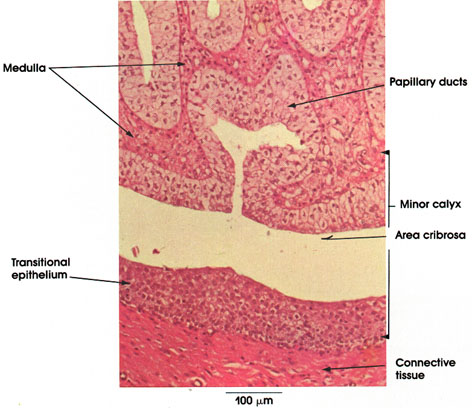

Plate 12.240 Kidney
Ronald A. Bergman, Ph.D., Adel K. Afifi, M.D., Paul M. Heidger,
Jr., Ph.D.
Peer Review Status: Externally Peer Reviewed

Rhesus monkey, Helly's fluid, H. & E., 162 x.
Papillary ducts (of Bellini): Named after Lorenz Bellini, the Italian anatomist, who described them in 1662. Arise by convergence of collecting tubules in the medulla near the pelvis. These ducts have large lumina and open at the area cribrosa at the apex of the papilla. Note the tall columnar epithelium lining the ducts. Cytoplasm of epithelial cells is clear; nuclei are dark and basally located. The tops of cells tend to bulge into the lumen.
Minor calyx: Subdivision of a major calyx in the pelvis of the kidney. The minor calyx is an infolded tube forming a double-walled cup. The inner wall of the calyx fits over the papilla of a pyramid. The transitional epithelium of the minor calyx is continuous with the columnar epithelium of the papillary ducts. The lamina propria is made up mostly of collagenous connective tissue and lacks papillae.
Area cribrosa: The sieve-like appearance of the papilla is produced by the large number of collecting tubules passing through it.
Next Page | Previous Page | Section Top | Title Page
Please send us comments by filling out our Comment Form.
All contents copyright © 1995-2025 the Author(s) and Michael P. D'Alessandro, M.D. All rights reserved.
"Anatomy Atlases", the Anatomy Atlases logo, and "A digital library of anatomy information" are all Trademarks of Michael P. D'Alessandro, M.D.
Anatomy Atlases is funded in whole by Michael P. D'Alessandro, M.D. Advertising is not accepted.
Your personal information remains confidential and is not sold, leased, or given to any third party be they reliable or not.
The information contained in Anatomy Atlases is not a substitute for the medical care and advice of your physician. There may be variations in treatment that your physician may recommend based on individual facts and circumstances.
URL: http://www.anatomyatlases.org/